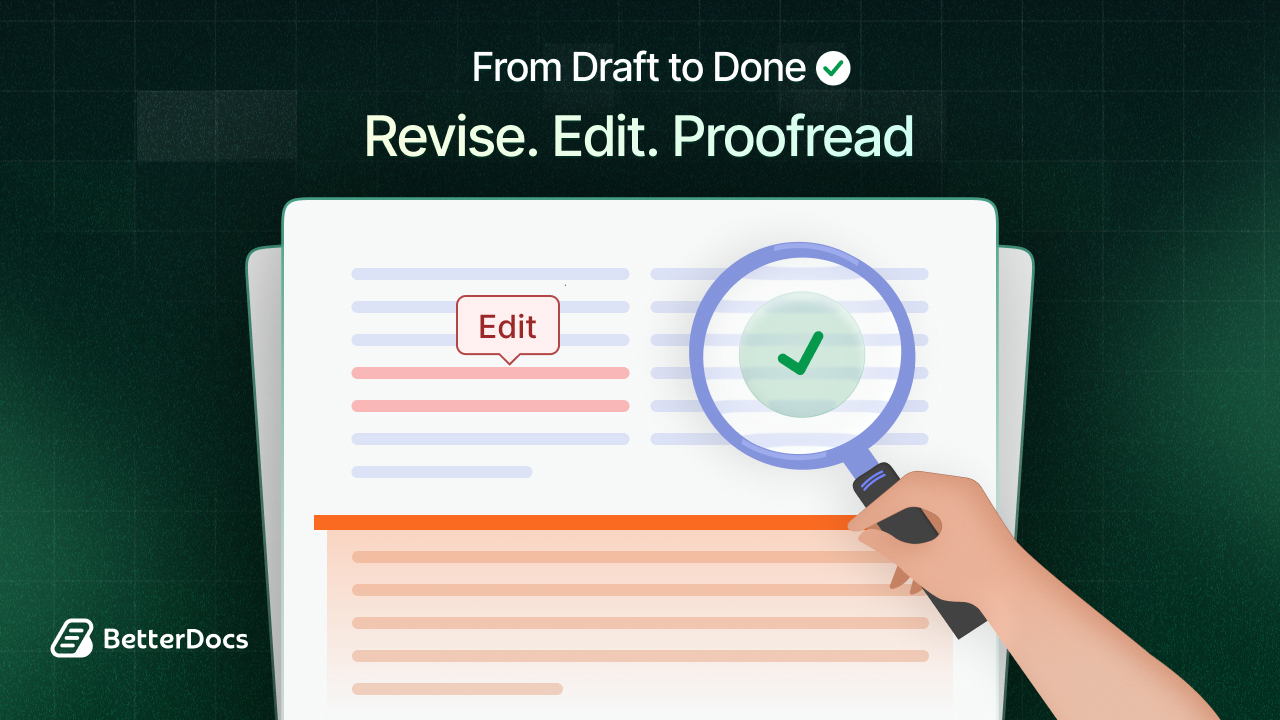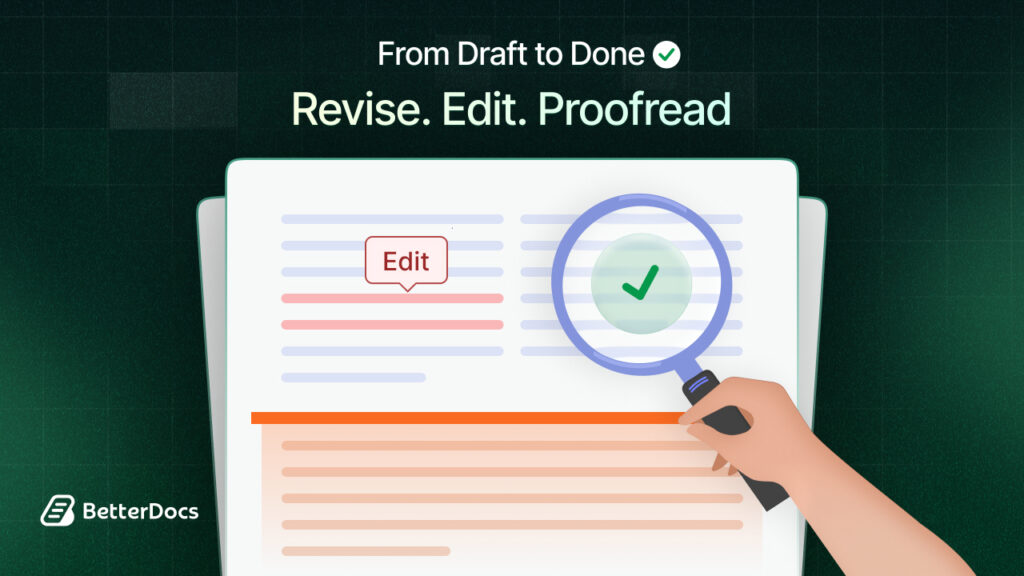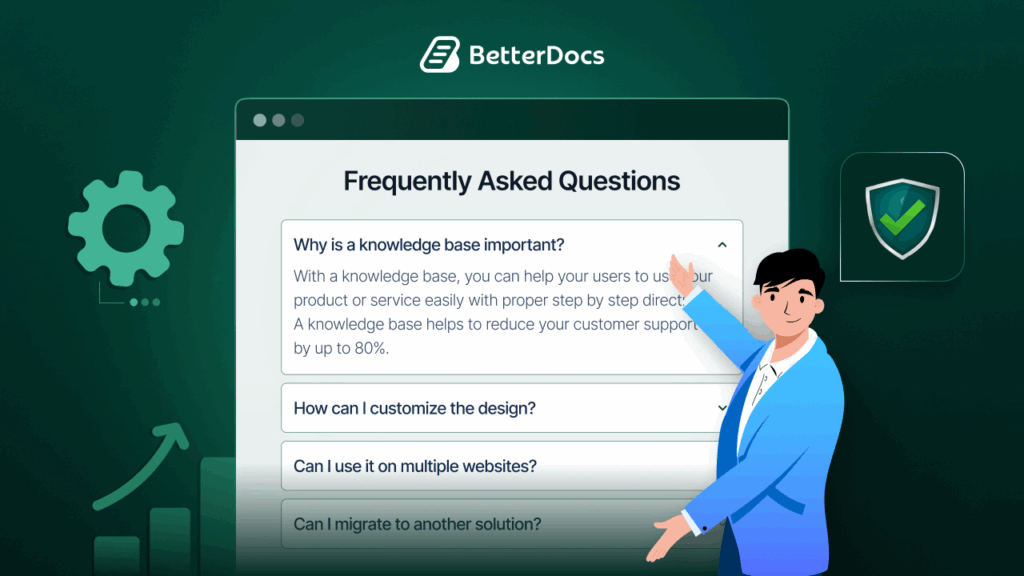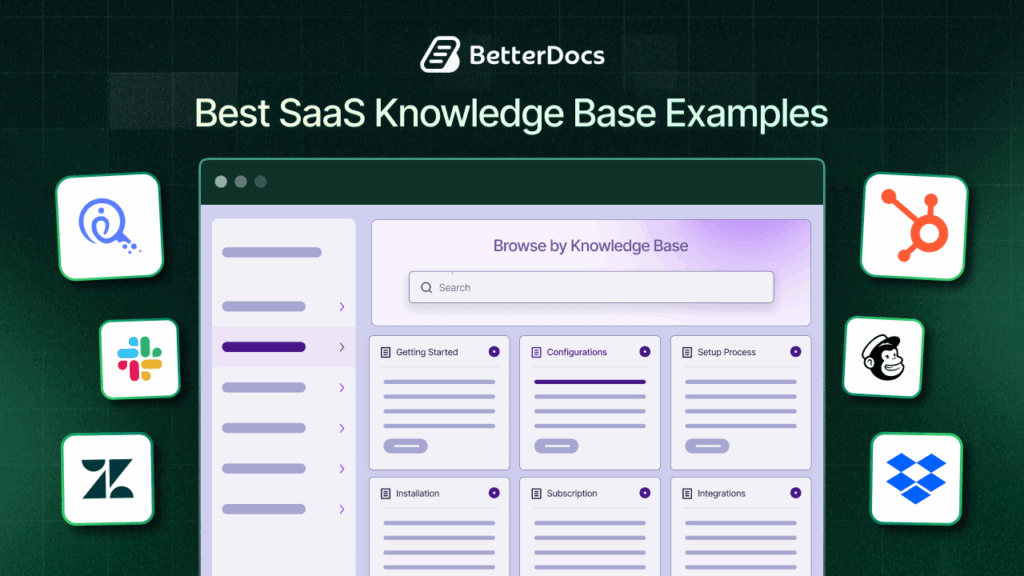Writing a perfect piece of content is never a one-step process. Whether you are working on a blog post, manuscript or business document, your first draft is just the beginning. The real magic happens during the writing process when you refine your work through three distinct stages: revising, editing and proofreading.

Many writers often confuse these terms or use them interchangeably but each serves a unique purpose in content improvement. Understanding the difference between revising, editing and proofreading can transform your writing from mediocre to exceptional.
What Is Revising?
Revising is the first and most comprehensive stage of the document review process. When you revise your work, you are looking at the big picture. This step focuses on the overall structure, flow and effectiveness of your content. Think of revising as reshaping your entire manuscript rather than just fixing small errors.

Revising often requires major changes, including rewriting paragraphs, reorganizing sections, adding new information, or removing content that does not contribute to your purpose.
Built for Easy Navigation
A strong structure keeps readers engaged and ensures your message is easy to follow. When revising, consider whether your introduction hooks the reader effectively, whether your conclusion leaves a lasting impact and whether all sections connect logically to create a smooth, coherent narrative.
Well-Structured Reasoning
Ensure that each point in the document is clear and straightforward. While revising, check that the main points are easily understood and that the central message is consistently conveyed throughout the text.
Well-Tuned Content
Quality content balances depth with readability. Make sure your writing includes enough detail to support your points, that every paragraph adds value and contributes meaningfully to the overall message and that unnecessary or redundant information is removed to keep readers focused.
Know Your Reader
Revising requires a constant focus on your readers. Ask yourself whether your content speaks directly to your target audience, whether your tone, language and examples are appropriate for those readers. Whether your content will achieve its intended purpose, whether to inform, persuade, or entertain.
What Is Editing?
After you complete the revising stage, editing becomes your next priority. Editing focuses on improving the clarity, readability and effectiveness of your writing at the sentence and paragraph level.

While revising deals with the big picture, editing zooms in on how you express your ideas. This stage of the writing process ensures your content is polished, precise and easy to understand.
Polish Your Structure
A key part of editing is improving the flow of your sentences. This often means breaking up long, complicated sentences into shorter, clearer ones and varying sentence length to create rhythm and maintain reader interest. Good editing ensures that each sentence connects naturally to the next, creating smooth transitions between ideas and a coherent reading experience.
Precision in Every Word
Editing also focuses on strengthening your language. Replace vague or overused words with specific, impactful alternatives and cut unnecessary phrases. Remove repetitive content that adds no value to your message. By doing this, your writing becomes sharper, more precise and more engaging for your readers.
Maintaining Consistency in Tone
Consistency is crucial in professional writing. During editing, check that your voice remains uniform throughout the document. Ensure that the level of formality is appropriate for your audience and that specialized terminology is used consistently. A consistent style helps readers trust your authority and understand your message more clearly.
No Room for Confusion
Editing is not just about aesthetics; it is about clarity. Rephrase confusing sentences and add context where necessary to prevent misinterpretation. Clear writing ensures that your ideas are easily understood and your readers stay engaged from start to finish.
Checking Grammar & Punctuation
While grammar and punctuation overlap with proofreading, editing addresses more complex issues that affect readability and meaning. Correct subject-verb agreement, maintain consistent verb tense and ensure proper punctuation usage. These refinements make your content polished and professional.
The Power of Effective Editing
Editing is where rough content transforms into high-impact writing. According to Grammarly, effective editing significantly improves both readability and engagement. This stage requires attention to detail, a solid understanding of writing mechanics and often multiple reads, each focusing on a different aspect of your text. By investing time in careful editing, you ensure that your message is clear, compelling and polished to perfection.
What Is Proofreading?
Proofreading is the final stage in the writing process and serves as your last line of defense against errors. This step occurs after you have completed both revising and editing. These include spelling errors, typos, incorrect punctuation and formatting inconsistencies.

Check Spelling
One of the main tasks in proofreading is identifying and correcting spelling mistakes. This includes typos, commonly confused words and errors that spell checkers might overlook. Proper names, technical terms and brand names should also be checked carefully to ensure accuracy every time they appear.
Fixing Punctuation
Proofreading also involves correcting punctuation errors. You need to check that commas, periods, semicolons and other punctuation marks are used correctly. Quotation marks should be paired properly and apostrophes must be placed accurately.
Ensuring Formatting Consistency
A polished document has consistent formatting throughout. During proofreading, verify that headings follow the same style, fonts and font sizes remain uniform, spacing and indentation are consistent, and bullet points or numbered lists are formatted correctly.
Catching Grammar Mistakes
While editing addresses complex grammar issues, proofreading catches simpler mistakes. This includes missing articles, incorrect plurals and basic subject-verb agreement errors that may have slipped through earlier stages.
Reviewing Visual Elements
If your document includes images, charts, or tables, proofreading ensures they are labeled correctly and referenced in the text. Captions should be accurate and all visual elements should display properly.
The Complete Documentation Process: Revising, Editing And Proofreading
Each stage builds on the previous one, guiding your work from a rough draft to a polished, professional piece. When approached systematically, these three stages ensure that every aspect of your content is carefully refined and nothing is overlooked.
The Writing Refinement Funnel: From Big Changes to Fine Details
Think of the writing process as a funnel →
⌛ Start with broad, structural changes during revising.
⌛ Focus on sentence-level improvements during editing.
⌛ Zoom in on tiny details and errors during proofreading.

This progression from macro to micro guarantees that both the overall structure and the smallest details are perfect.
1️⃣ Revising: Laying the Foundation
Revising comes first because it focuses on the big picture. There is no point in perfecting sentences or word choice for content you may later remove. During revision, you evaluate whether your ideas are clear, well-supported and organized logically. By establishing a strong foundation, you ensure that every part of your document serves a purpose before moving on to finer details.
2️⃣ Editing: Polishing Your Expression
Once the structure is solid, editing allows you to enhance your language and style. You refine sentence flow, choose stronger words and create smooth transitions between ideas. Editing is where your content gains clarity and rhythm, ensuring that your style matches your audience and every sentence communicates effectively.
3️⃣ Proofreading: The Final Polish
Proofreading is the last step in the process. After revising and editing, you perform a meticulous check for typos, punctuation errors, formatting inconsistencies and minor grammatical mistakes. This final polish makes your content professional, credible and ready to impress your readers.
Follow the Best Practices
In professional documentation, following a structured three-step process of revising, editing and proofreading helps ensure clarity. It also improves accuracy as well as consistency. This process is commonly used in manuals, guides, ज्ञानधार articles and technical documents. Each type of document benefits from careful review at every stage.

Before sharing your document, review it carefully. Follow revising, editing, and proofreading to ensure clarity, accuracy and professionalism. Use this checklist to stay on track.
Practical Tips & Common Avoidance for Each Stage
Knowing the difference between revising, editing, and proofreading is one thing, but applying that knowledge effectively is what transforms your writing. Here is a straightforward guide with practical strategies for each stage.
| Stage | Practical Tips | Common Mistakes to Avoid |
| Revising | 💠 Set your draft aside for a day before starting. 💠 Read through the draft without making changes initially. 💠 Ask big-picture questions: Does the introduction state the main point? Do paragraphs support the message? Is the conclusion strong? 💠 Keep your audience in mind; remove anything irrelevant. | 💠 Skipping revision and jumping straight to editing. 💠 Trying to revise and edit at the same time. 💠 Ignoring audience needs and leaving irrelevant content. |
| Editing | 💠 Read your work aloud to catch awkward phrasing. Remove unnecessary words like “very” or “really.” 💠 Replace passive voice with active voice to make clear and concise documents. 💠 Check transitions to ensure smooth flow between paragraphs. 💠 Group related ideas logically. | 💠 Over-editing while revising. Example: Changing a clear instruction like “Click Save” into longer versions unnecessarily while revising. 💠 Ignoring sentence flow and transitions. 💠 Using redundant phrases or weak words. Such as— very really, just, quite, perhaps, etc. |
| Proofreading | 💠 Focus on one type of error at a time (spelling, punctuation, grammar). 💠 Use spell checkers. 💠 Check formatting consistency and visual elements like charts or tables. | 💠 Relying solely on automated tools. 💠Rushing through the final check. 💠Ignoring formatting and minor errors. |
From Draft to Done: Ensure Every Detail Counts
Every effective document is the result of careful review and multiple layers of refinement. Revising, editing and proofreading each serve a specific purpose in ensuring your content is clear with accuracy.
Together, these steps turn a draft into clear and accurate documentation. The aim is not to be perfect at first but to carefully refine and check your content so it is easy to understand and reliable.
Found this blog helpful? Share your thoughts in our Facebook Community तथा subscribe to our blog for more tips and insights.





